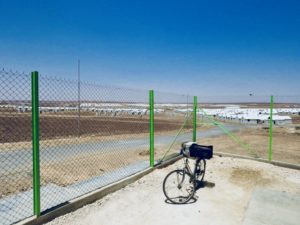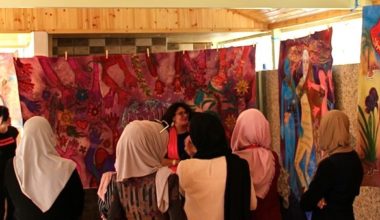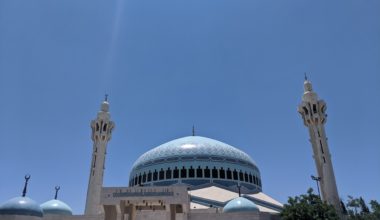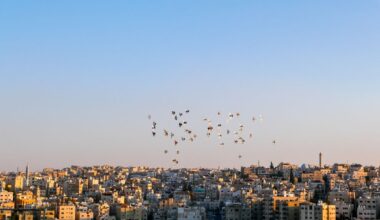
By Melissa Gatter, a 2018 CBRL travel grant recipient and PhD candidate in Middle Eastern Studies at the University of Cambridge.
“But I’ve gotten used to it. I’ve acclimated,” Aya says, describing her journey to Azraq refugee camp that ended in Village 5, the part of the camp she is not allowed to leave.
We’re sitting in her office at a small NGO centre overlooking Village 5. Aya, the site’s director, sits across from me, my elbows resting on the desk in between us, her arms cradling her new-born baby. He is her sixth child, the first to be born in Azraq, the second to be born in displacement.

We’ve sat like this many times over the months of my ethnographic fieldwork, except sometimes I am the one holding the baby. Our conversations are never dull. Today we’re talking about her Syrian culture that she feels has helped her survive life in Azraq. “In rural Aleppo, they say that girls have to be strong. They leave the house, they go to work. I think in the camp I’ve been pretty strong. I’ve held on to this, and I always will.”
Aya describes herself as being at once vulnerable – “the term ‘refugee’ is a very painful one, Melissa, in all its meanings” – and adapting to her new circumstances. However, she isn’t exactly new to Azraq, having lived there for two and a half years. “That’s a lifetime, isn’t it?”
The other 8,500 residents of Village 5 are, similarly to Aya, deemed the most vulnerable because they are the newcomers, even though most have been there for two or three years. As one aid worker told me, “I prefer working in Village 5 to the older villages because you really feel like you are helping, you have to give people the basic of the basic needs. Whereas in Village 3, people already know what the NGOs are supposed to do and they’re just more fed up.”
This ‘honeymoon period’ regarding a refugee’s newness to the camp and their vulnerability in the eyes of humanitarians has been echoed by many other aid workers. One of them said of Village 5’s residents, “Because they’re new to the camp, they still don’t know what’s going on, so you guide them on what they should do.” As a result, aid workers feel not only that they are more needed in Village 5, but also that their work is more appreciated.

This hierarchy of vulnerability occurs against the adaptation of refugees to the camp, as Aya mentions above. There are signs of people moving forward in Azraq: worn-down short-cuts in the sand appear between the paved roads, gardens bloom among the neighborhoods, make-shift shelves and dividers help to organize the interior of caravans. One aid worker said of the two villages with access to electricity, “They all have TVs and refrigerators now! People in Village 3 used to complain that they didn’t have shoes, now they complain they don’t have refrigerators and TVs!”
While the aid worker’s comment is an exaggeration, it points out the physical developments that have taken place in Azraq over its four years and the changing expectations of those who have been there from the beginning. These adaptations are seen even in the ‘new’ Village 2 and 5, where residents are resourceful in creating energy to run fans and small television screens. However, what is more telling about refugees’ adaptation to the space of the camp is the changes, and lack thereof, that camp dwellers have made in their culture and traditions.
Walking among the caravans, I noted many Syrian traditions. Families offered me sweet mint tea and scolding hot Arabic black coffee. Pouring from a vacuum flask into a tiny cup, they would tell me, “You must drink it in three sips,” lest I hesitate for fear of burning my tongue. Jordanian aid workers would even conform to the Syrian dialect when greeting and speaking with refugees – “Hiyullah!” they would say with a friendly wave. Clothing, food, and music all remain steadfastly Syrian.

As the 40,000 refugees in Azraq come from a mix of Syrian towns, such as Aleppo, Homs, Damascus, Dar’a, and Raqqa, there is some variation in tradition. The most notable is education and social relations, which aid workers liken to cultural differences. For Aya, her Aleppan background means that she is able to study and work, but for many women in the camp, this is out of reach.
But many aid workers have noted that this culture is slowly changing. While holding on to their traditions, Syrian refugees are “looking to their culture for things that can be useful to them in the camp,” as one aid worker said, and this has caused some transformation. According to aid workers, many more girls are going to school in the camp, and some families have stopped marrying their children underage.
This is partly due to humanitarian programming that spreads messaging about education, child marriage, and child labor. However, aid workers are aware of the fine lines they are treading in such messages, as one mentioned, “I want to help them, but I also want to respect their culture.” Many refugees have engaged in certain cultural practices for generations, regardless of conflict, and thus many find it hard to understand why NGOs are focusing on changing these practices.
Nonetheless, refugees are transforming their cultures and holding on to their traditions in their own way and in their own time, as best suits their situation. Syrian heritage in Azraq is rooted more deeply than the camp’s infrastructure, and unlike these structures, which are pressed to the ground in concrete foundations, is malleable and adapting, ready to be carried along wherever these residents must be rooted next.
For Aya, as for many others in Azraq, Syrian heritage is the key to a Syrian future. While she is adapting to the difficulties of the camp and finds her refugee label revealing vulnerability, her Syrian culture and traditions ground her in the time being. “I want to go back to Syria. We have to go back to rebuild, everyone carries this responsibility, because if we don’t—the people of the countryside, the educated, the laborers—who will rebuild Syria?”
Melissa Gatter is a PhD candidate in Middle Eastern Studies at the University of Cambridge and a recipient of the CBRL 2018 travel grant. Her ethnographic fieldwork explores aspects of time and nostalgia in Azraq refugee camp for Syrians in Jordan. She completed her MPhil at Cambridge in 2016, and her dissertation, ‘Remaking Childhood: Humanitarianism and Growing Up Syrian in Za’atari Refugee Camp’, focused on notions of childhood and Syrian identity in Jordan’s largest populated refugee camp. Broadly, her research interests include displacement and nationalism in the Middle East, interactions between aid workers and refugees, and refugee identity and agency in temporary spaces of refuge. Melissa holds a BA from the University of Chicago.
The views expressed by our authors on the CBRL blog are not necessarily endorsed by CBRL, but are commended as contributing to public debate.














